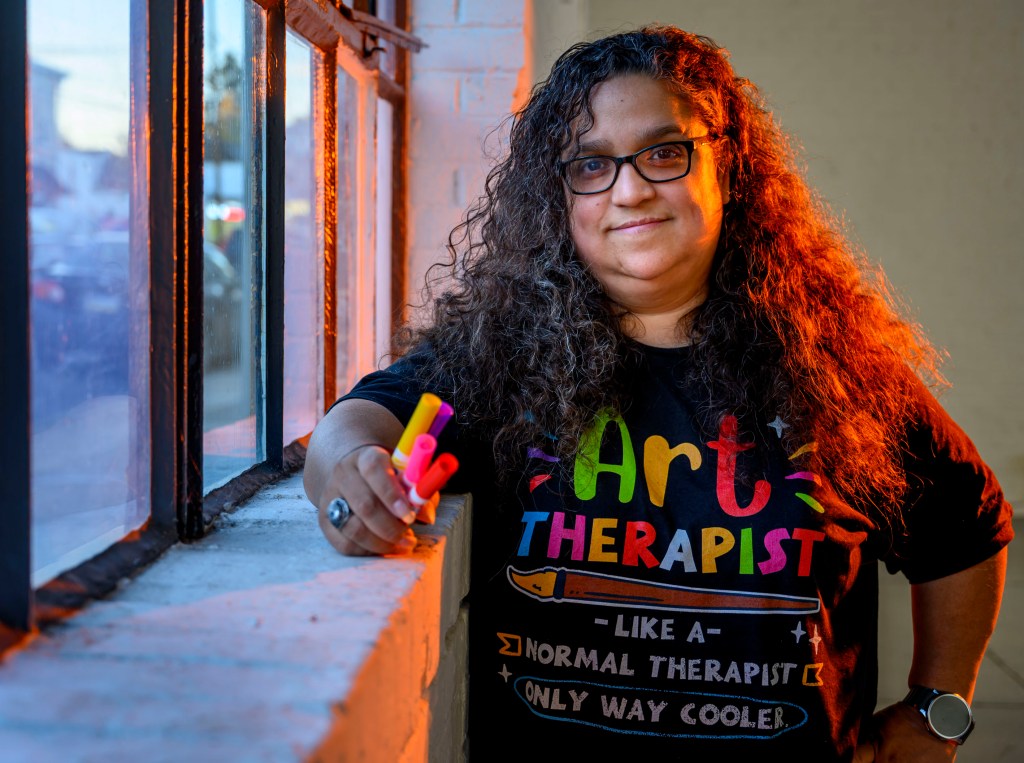When last we saw Cindy Rodriguez, she was poking among tombstones at Easton Cemetery, looking for wandering spirits and even finding a few, if you can credit the findings of the modern ghost hunter’s spectral cameras and other Scooby gang gadgetry.
Chasing ghosts is only a sideline, though. In daily life, Rodriguez, 54, is a certified art therapist, using far more prosaic tools — crayons, markers, clay — to help children and adults uncork moods and feelings and traumas, and spill them onto canvases or shape them into three-dimensional forms.
Her newest role is resident art therapist for ArtsQuest, through which she conducts classes for children at four elementary schools in Bethlehem Area School District.
“A really nice gig,” she called it, enthusing over the efforts of children who dive into artwork without the least trace of self-consciousness, the creativity-killer that besets so many adults.
Rodriguez offers public programs, too, through her business, the Healing Palette Art Therapy. This month she’s been conducting weekly 90-minute sessions for all ages at the Soft Machine Gallery in Allentown.
On a recent evening Rodriguez sat in the gallery, sporting one of her favorite T-shirts — “Art Therapist: Like Normal Therapist, Only Way Cooler” — and musing about the stigma that still seems to hold sway when it comes to mental illness.
It’s a reticence the Allentown resident considers harmful and even dangerous in a day and age charitably described as eventful.
“I feel like it’s the most normal thing in the world for people to have a therapist,” she said, recounting her own youthful struggles with depression and flirtations with suicide — troubles she captured in a spoken-word poem performed as part of her art therapy master’s degree thesis at Cedar Crest College.
“When I was 16 I took a handful of pills, my will to live was weak/Hate my physique/Felt like my future was bleak/Depression and anxiety/Felt like a freak of society … “
It has an anthemic tone, capturing the anxieties that beset all young people to some extent. Knowing the children in her elementary classes will reach the churning waters of adolescence in just a few years, Rodriguez said her work has a particular urgency.
“They may be getting smarter and techier,” she said, “but they don’t know how to handle their feelings.”
It’s a problem that, in the worst cases, can metastasize into violence.
“I don’t want to see any of these kids on CNN one night,” Rodriguez said, evoking television coverage of mass shootings that has become so chillingly commonplace in the past two decades.
Not all participants take to art therapy right away, and Rodriguez doesn’t push. Sometimes their enthusiasm is sparked by a change in medium — a client who turns a cold shoulder to drawing or collage-making might take to clay-molding or painting.
How well they draw or paint or sculpt is beside the point. For Rodriguez, a lifelong artist who exhibits in galleries, aesthetic achievement is essential. In therapy, it’s secondary to the meditative and exploratory process of making.
“I’m teaching them how to cope and express their feelings through art,” she said. “It’s not art for art’s sake. It’s using art when words aren’t enough, when you can’t find the words.”
In some cases, therapy can turn up unresolved traumas or wounds that need to be explored further. It also can give participants simple tools to reduce stress and ease the distracting jumble of thoughts that accompanies life in modern society.
“It’s definitely a release and a bit of reflection,” said John Mortensen, who co-owns Soft Machine with his wife, Eva Di Orio.
Mortensen took part in Rodriguez’ first class at the gallery and found particular value in an exercise called “5-4-3-2-1,” in which participants create art inspired by the five senses: five things they see, four things they hear, three things they smell, and so on.
It’s the artist’s version of a deep-breathing exercise, focusing the mind to push away anxiety-provoking distractions.
“It let out a bit of frustration,” Mortensen said. “I still use it today.”
Rodriguez foresees expanding her audience. She’s especially interested in working with the front-line groups — police, paramedics, soldiers, doctors, nurses — whose jobs put them at high risk for post-traumatic stress disorder.
In the meantime, she is busy with other work, pursuing a doctorate in expressive therapies and marketing fashion and accessories of her own design through her Underworld Art Studio.
Rodriguez said the popularity of art therapy is growing. The best proof of that, perhaps, was last year’s introduction of the Barbie Art Therapy Playset, placing the practice squarely in the mainstream of the mental health field.
It was cheering moment for therapists, whose services are increasingly in demand.
“People are not well right now,” Rodriguez said, sizing up the fragmented, digitized and divisive landscape, far more unnerving in its way than the spooky world of her sideline job among the tombstones.
Morning Call reporter Daniel Patrick Sheehan can be reached at 610-820-6598 or dsheehan@mcall.com.
Originally Published: October 20, 2025 at 7:00 AM EDT

